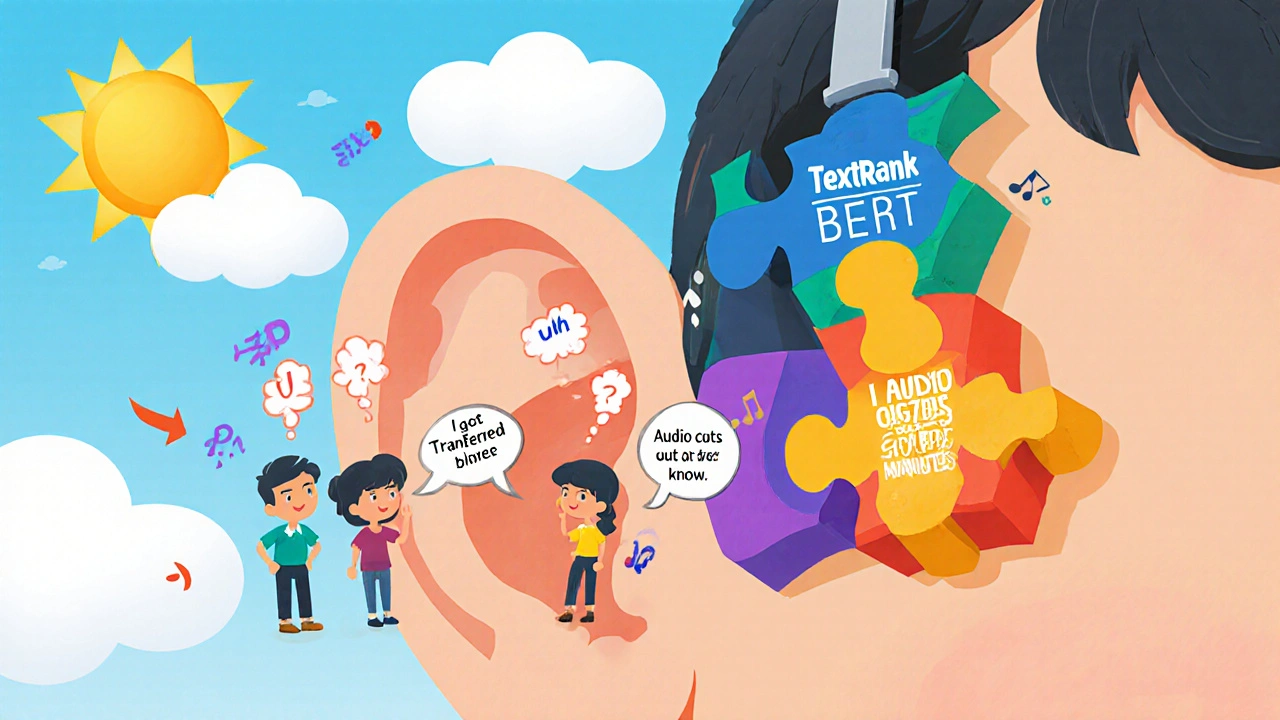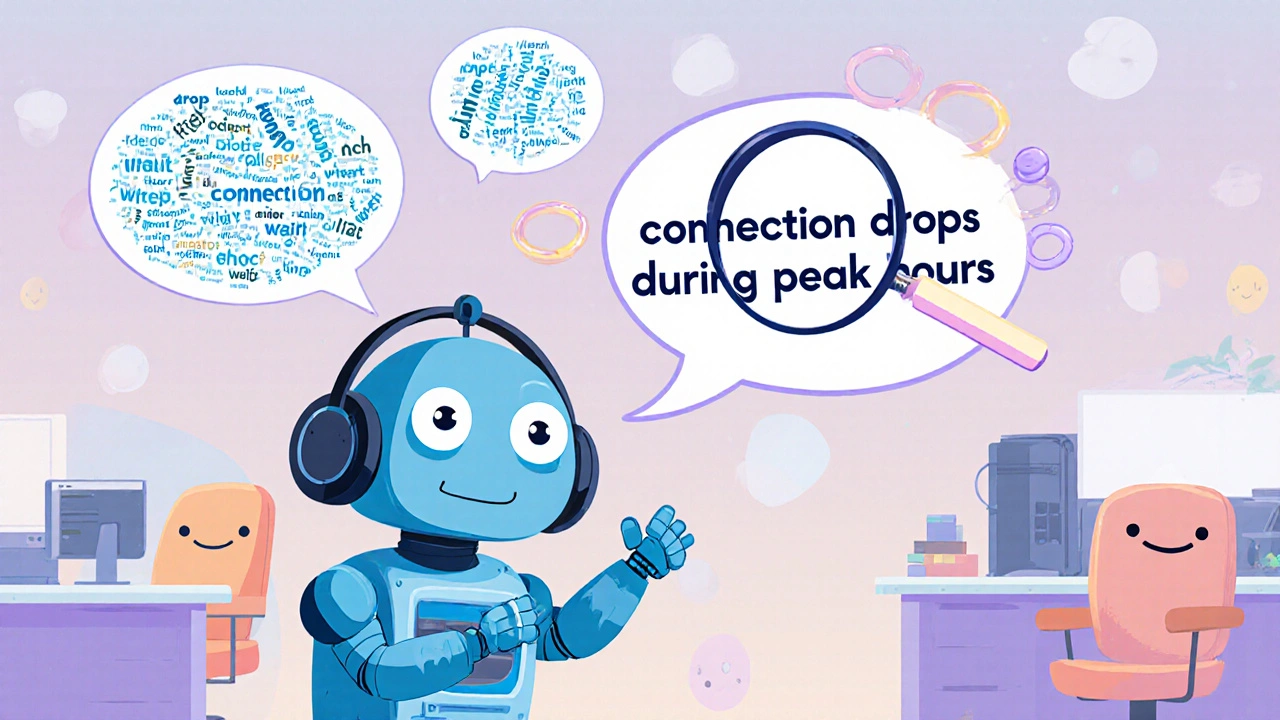When you analyze VoIP call logs, you’re not just looking at timestamps and durations. You’re swimming in raw, unstructured conversations-hundreds, maybe thousands of them. And buried in those calls are the real signals: what customers care about, where they get frustrated, what features they love. The problem? Manually reading every call is impossible. That’s where keyword detection comes in. It’s not about counting how many times someone says "price" or "support." It’s about understanding the context behind those words-so you can act on what actually matters.
Why Keyword Detection Matters in VoIP Analytics
VoIP systems generate massive amounts of audio data. Most companies transcribe those calls using AI, turning speech into text. But raw transcripts are messy. They’re full of filler words, interruptions, and vague phrases like "I don’t know" or "it’s complicated." Without keyword detection, you’re left with noise.
Think about it: if 200 customers mention "connection drops" in their calls, but your system only flags "drop" because it’s a common word, you miss the real issue. Keyword detection filters out the fluff and finds the meaningful phrases-"connection drops during peak hours," "audio cuts out after 10 minutes," "caller can’t hear me on mobile." These aren’t just keywords. They’re problems waiting to be fixed.
Companies using keyword detection in VoIP analytics report 40-60% faster identification of recurring customer pain points. One UK-based call center saw a 32% drop in churn after using keyword trends to retrain agents on handling billing complaints-something they’d missed for months because the word "bill" was buried under hundreds of other mentions.
How Keyword Detection Works in VoIP Systems
Keyword detection in VoIP analytics isn’t magic. It’s a mix of three proven techniques: statistical, graph-based, and embedding-based methods. Each has strengths and weaknesses.
Statistical methods like TF-IDF (Term Frequency-Inverse Document Frequency) measure how often a word appears in a call transcript compared to all other transcripts. Simple? Yes. Effective? Only sometimes. TF-IDF will miss rare but critical phrases like "my line keeps disconnecting when I’m on hold"-because it only looks at frequency, not meaning. If a phrase only shows up in one call, TF-IDF ignores it. But that one call might be from a high-value customer.
Graph-based methods like TextRank treat words as nodes in a network. If two words appear close together in a sentence-like "audio" and "lag"-they get connected. The system then figures out which words are most "central" in that network. This method catches phrases even if they’re rare, because it understands context. TextRank is why your system can spot "delayed response during conference calls" as a key issue, even if it only happened three times.
Embedding-based methods use AI models like BERT or GPT-3.5 to understand meaning. These models don’t just see words-they see how they’re used. If someone says, "Apple keeps dropping my call," the system knows it’s talking about the phone brand, not the fruit. This is critical in VoIP, where words like "line," "call," or "server" can mean totally different things depending on context.
Most modern VoIP analytics platforms combine these methods. They use TF-IDF to filter out obvious noise, TextRank to find meaningful phrases, and embeddings to understand what those phrases really mean.
What Makes a Good Keyword in VoIP Data?
Not every repeated word is a keyword. A good keyword in VoIP analytics has three traits:
- It’s specific-"bad sound" is too vague. "Echo during outbound calls on Android devices" is specific.
- It’s actionable-if you can’t fix it, it’s not useful. "Customers say they can’t hear the agent" is fixable. "Customers feel ignored" is not.
- It’s consistent-if only one person says "the system is broken," it’s an outlier. If 15 people say "the IVR hangs after the third option," that’s a pattern.
Here’s a real example from a VoIP provider in Exeter:
They noticed a spike in calls mentioning "transfer" and "wait time." At first, they thought agents were slow. But keyword detection revealed the real issue: "I got transferred three times and still didn’t talk to anyone." That’s not about agent speed-it’s about routing logic. They fixed the IVR flow, and average call handle time dropped by 22%.

Tools and Technologies Behind the Scenes
You don’t need to build this from scratch. Several tools power keyword detection in VoIP systems today.
- spaCy and NLTK-open-source Python libraries used for preprocessing. They strip out stop words ("the," "and," "is") and break text into meaningful chunks.
- TextRank-still the most common algorithm in enterprise VoIP platforms. It’s reliable, explainable, and works well with short transcripts.
- OpenAI’s GPT-3.5-used by top-tier platforms to understand intent. It can detect sarcasm, frustration, and urgency in tone, even when the words seem neutral.
- TextRazor and Twinword-commercial APIs that combine keyword extraction with entity recognition. They can pull out names of products, locations, and even competitor brands mentioned in calls.
One major UK telecom provider switched from a basic TF-IDF system to a hybrid model using TextRank + GPT-3.5. Their ability to detect "complaints" improved by 51%, and they started catching issues like "your competitor offers this for cheaper"-something their old system completely missed.
Common Mistakes and How to Avoid Them
Even with the right tools, people make the same mistakes over and over.
- Ignoring domain-specific terms-In VoIP, "SIP" isn’t a word-it’s a protocol. "QoS" isn’t jargon-it’s quality of service. If your system doesn’t recognize industry terms, you’ll miss critical signals.
- Over-filtering-Some systems remove all numbers, thinking they’re noise. But "500ms latency" or "3 failed attempts" are gold. Keep numeric phrases.
- Not tagging by caller type-A keyword like "refund" means something different coming from a new customer vs. a long-term subscriber. Segment your data.
- Forgetting time trends-If "echo" spikes every Monday morning, it’s likely a network issue after weekend maintenance. Keyword detection without time context is useless.
One company kept seeing "slow" as a top keyword. They assumed it was about speed. Turns out, customers meant "slow to answer." They’d misconfigured their call queue settings. A simple fix-reducing the ring time before transfer-cut that complaint by 78%.

How to Start Using Keyword Detection Today
You don’t need a team of data scientists. Here’s how to begin:
- Export your top 100 transcribed calls-focus on complaints, cancellations, or support tickets.
- Use a free tool like YAKE or spaCy-both are open-source and easy to run locally.
- Look for phrases that repeat 3+ times-ignore single mentions unless they’re from high-value customers.
- Ask: "Can we fix this?"-If yes, prioritize it. If no, file it for future trends.
- Share findings with your team-train agents on the top 3 issues. Update your IVR scripts. Adjust routing rules.
Within two weeks, you’ll start seeing patterns. Within a month, you’ll be making data-driven changes instead of guessing.
The Future: Where Keyword Detection Is Headed
By 2025, 70% of enterprise VoIP systems will use AI-powered keyword detection as standard (Gartner, 2023). But the next leap isn’t just about finding words-it’s about connecting them.
Future systems will link keywords to:
- Customer profiles
- Network performance logs
- Agent performance scores
- Competitor pricing mentions
Imagine this: a customer says, "I’m switching to Acme because your call quality is worse than theirs." The system doesn’t just flag "Acme"-it ties that comment to the customer’s recent call drops, their location, and the fact that Acme offers a free trial. Then it auto-generates a retention offer.
That’s the future. And it’s closer than you think.
Final Thought: It’s Not About Keywords-It’s About Understanding
Keyword detection isn’t about automation. It’s about listening better.
VoIP calls are where your customers speak freely. They don’t fill out surveys. They don’t click on ratings. They talk. And if you’re not using keyword detection to hear what they’re really saying, you’re missing the most valuable data you have.
Start small. Focus on one problem. Let the data show you the way. Then scale.
What’s the difference between keyword detection and sentiment analysis in VoIP analytics?
Keyword detection finds what people are talking about-like "echo," "dropped calls," or "billing error." Sentiment analysis tells you how they feel about it-frustrated, angry, satisfied. You need both. Keywords tell you the problem. Sentiment tells you how urgent it is.
Can keyword detection work with non-English VoIP calls?
Yes, but accuracy drops. Most systems perform 20-30% worse on non-English transcripts due to less training data and language-specific grammar. For multilingual support, use platforms like TextRazor or Twinword that support 20+ languages. Always test with real local calls before rolling out.
Do I need to transcribe all my calls to use keyword detection?
Not all-just the ones that matter. Start with high-value calls: complaints, cancellations, support tickets, or calls longer than 5 minutes. Transcribing everything is expensive and unnecessary. Focus on quality over quantity.
Is keyword detection GDPR-compliant?
It depends on how you use it. If you’re analyzing anonymized transcripts and not storing personal identifiers (names, numbers, addresses), you’re likely compliant. Always remove PII before analysis. Use platforms that offer built-in GDPR filters, and document your data handling process.
How long does it take to see results from keyword detection?
You can see patterns in as little as 48 hours if you analyze 50-100 transcripts. Real business impact-like reduced churn or improved CSAT-usually takes 2-4 weeks after you act on the findings. The key is speed: detect, decide, act, repeat.
